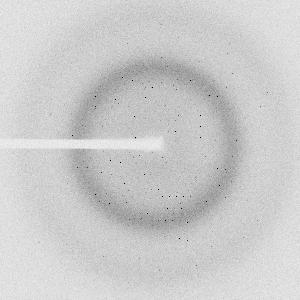A public database of macromolecular diffraction experiments

Each dot forms from the constructive interference of X-rays passing through a crystal. The data can be used to examine the crystal's structure. Credit: M. Grabowski et al.
Macromolecular X-ray crystallography has led the way in requiring the public dissemination of atomic coordinates and a wealth of experimental data via the Protein Data Bank (PDB) and similar projects, making the field one of the most reproducible in the biological sciences.
The IUCr commissioned the Diffraction Data Deposition Working Group (DDDWG) in 2011 to examine the benefits and feasibility of archiving raw diffraction images in crystallography. The 2011-2014 DDDWG triennial report made several key recommendations regarding the preservation of raw diffraction data. However, there remains no mandate for public disclosure of the original diffraction data.
The Integrated Resource for Reproducibility in Macromolecular Crystallography (IRRMC) is part of the Big Data to Knowledge programme of the National Institutes of Health and has been developed to archive raw data from diffraction experiments and, equally importantly, to provide related metadata. The database [Grabowski et al. (2016). Acta Cryst. D72, 1181-1193, doi:10.1107/S2059798316014716], contains at the time of writing 3070 macromolecular diffraction experiments (5983 datasets) and their corresponding partially curated metadata, accounting for around 3% of all depositions in the Protein Data Bank.
The resource is accessible at http://www.
Talking to a reporter about the project, team leader Wladek Minor said, “There is so much research underway that it can't all be published, and often the results of unsuccessful studies don't appear in the literature. I think the key to success is to know about unsuccessful experiments, we want to know why they fail”.
The goal of the project is to expand the IRRMC and include data sets that failed to yield X-ray structures. This could facilitate collaborative efforts to improve protein structure-determination methods and also ensure the availability of “orphan” data left behind by individual investigators and/or extinct structural genomics projects.
Media Contact
All latest news from the category: Life Sciences and Chemistry
Articles and reports from the Life Sciences and chemistry area deal with applied and basic research into modern biology, chemistry and human medicine.
Valuable information can be found on a range of life sciences fields including bacteriology, biochemistry, bionics, bioinformatics, biophysics, biotechnology, genetics, geobotany, human biology, marine biology, microbiology, molecular biology, cellular biology, zoology, bioinorganic chemistry, microchemistry and environmental chemistry.
Newest articles

Superradiant atoms could push the boundaries of how precisely time can be measured
Superradiant atoms can help us measure time more precisely than ever. In a new study, researchers from the University of Copenhagen present a new method for measuring the time interval,…

Ion thermoelectric conversion devices for near room temperature
The electrode sheet of the thermoelectric device consists of ionic hydrogel, which is sandwiched between the electrodes to form, and the Prussian blue on the electrode undergoes a redox reaction…

Zap Energy achieves 37-million-degree temperatures in a compact device
New publication reports record electron temperatures for a small-scale, sheared-flow-stabilized Z-pinch fusion device. In the nine decades since humans first produced fusion reactions, only a few fusion technologies have demonstrated…





















